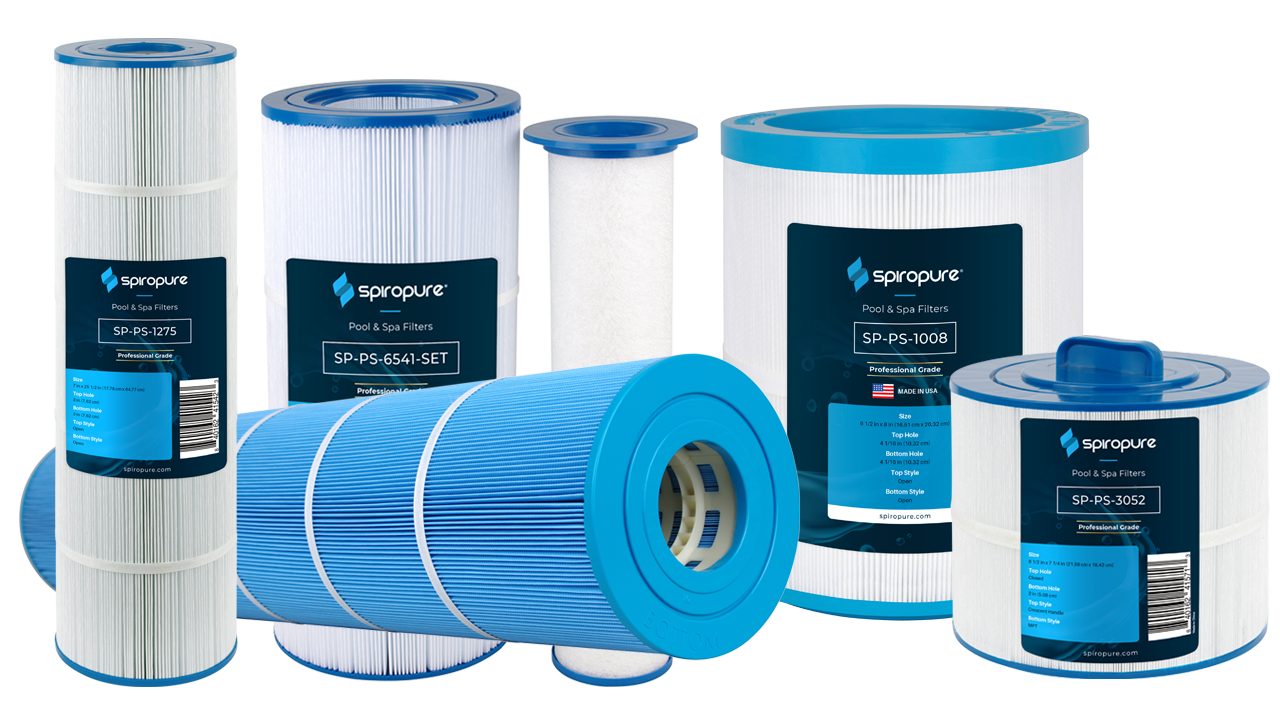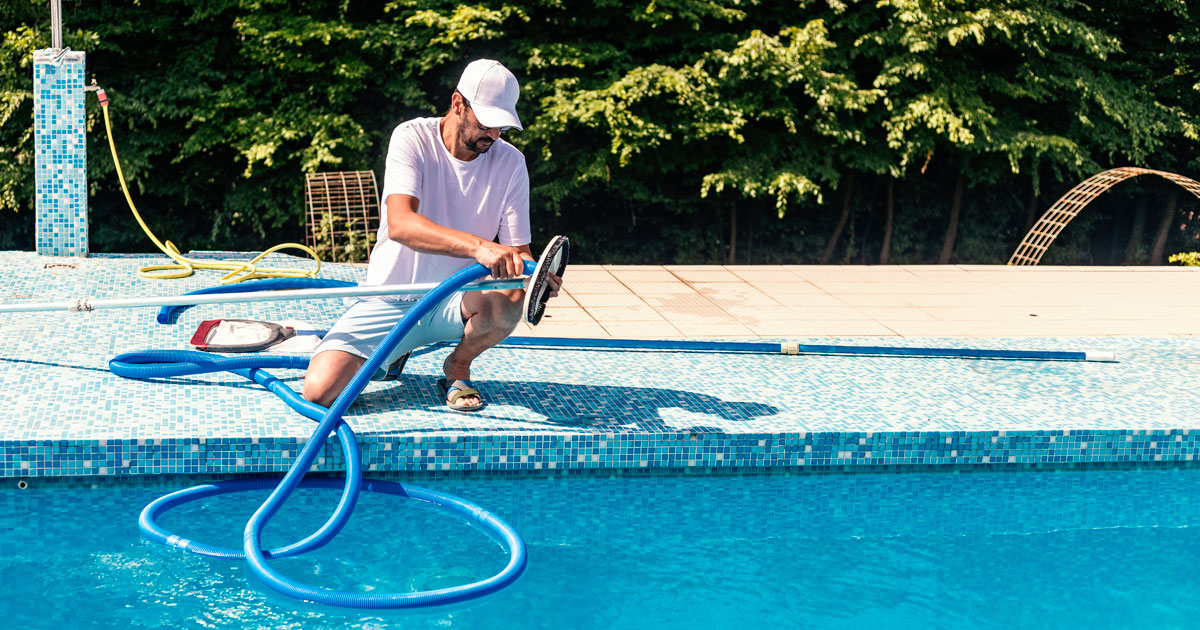Pool Filter Types Compared: Finding the Right System for Your Pool
 Andrew
November 26, 2025
#cartridgefilter
#defilter
#filtercleaning
#filterreplacement
#filtertypes
#poolfilter
#sandfilter
#spafilter
Andrew
November 26, 2025
#cartridgefilter
#defilter
#filtercleaning
#filterreplacement
#filtertypes
#poolfilter
#sandfilter
#spafilter

- Compare sand, DE, and cartridge filtration systems to help you understand how each works
- Break down the real-world costs and maintenance requirements for each filter type
- Help you choose the right filtration system based on your pool size, budget, and maintenance preferences
Sand Filters
Sand filters have a long history in pool and spa filtration. A tank filled with specially graded sand traps contaminants as water passes through. Water enters the top of the filter housing and flows downward through the sand bed, where particles become trapped between sand grains. Sand filters remove particles as small as 20 microns and require periodic backwashing and rinsing to reverse water flow and flush out accumulated debris.
These systems work well for larger inground pools where automated maintenance is valued over maximum filtration efficiency. The backwashing process can be programmed to occur automatically on some models. Be aware that backwashing uses a few hundred gallons of water per session, making them less environmentally friendly.
For pool and spa applications, sand filters are less commonly used in hot tubs due to their maintenance requirements in smaller water volumes, though they remain a solid choice for budget-conscious pool owners who don't mind a couple extra tasks to keep them functioning properly.

DE (Diatomaceous Earth) Filters
DE filters offer the finest filtration available, capturing particles down to around 3 microns using a white powder made from fossilized diatoms. Diatoms are worth a brief digression into paleontology. They're microscopic marine organisms that left behind shells of strong and porous silica so perfectly designed for filtration that we're still scooping up and using their fossilized remains millions of years later. This powder coats fabric-covered grids inside the filter housing, creating an extremely fine filtration barrier that removes microscopic contaminants other systems miss.
While DE filters excel at water clarity, they require more complex maintenance than other options. The DE powder must be periodically added to the system, and spent DE and trapped contaminants must be disposed of properly. These filters work well for pool applications where water clarity is paramount, but they may be less practical for hot tubs and spas because hot water with body oils and lotions coats the filter more quickly, requiring frequent maintenance.
Cartridge Filters
Cartridge filters strike a balance between performance and convenience, using pleated polyester media housed in plastic end caps to trap contaminants. These filters can capture a range of particles while requiring no backwashing or chemical additives.
The pleated design creates substantial surface area for filtration while allowing easy removal for cleaning. Larger filters can have more than 300 square feet of filter media. Cartridge filters are the most popular choice for hot tubs and spas because they handle the oils and lotions common in hot water environments better than other options. For pool and spa owners seeking minimal maintenance complexity, cartridge filter systems offer an appealing middle ground.
Cost Comparison
Initial equipment costs favor sand filters, which typically represent the most budget-friendly option for new installations. DE filters generally carry the highest upfront cost, while cartridge systems fall somewhere in-between. Ongoing expenses tell a different story.
Sand filter maintenance involves periodic sand replacement every 3-5 years and increased water costs from backwashing. DE filters require regular powder purchases and more complex maintenance procedures. Cartridge filters need periodic replacement every 6 months to 3 years depending on usage and care, but eliminate water waste from backwashing.
Maintenance Requirements
Sand filters do require some hands-on maintenance, though with a little practice the process of backwashing isn't much effort. Most of the work goes into scrubbing down the pool. DE filters require regular monitoring, backwashing, replenishing, and proper disposal of spent media. For pool owners who want maximum water clarity, this trade-off may be worthwhile.

Cartridge filters offer the simplest routine maintenance: remove, rinse, and reinstall. No chemicals or backwashing are required, making them ideal for pool and spa owners who prefer straightforward maintenance routines. For above-ground pools and smaller installations, this simplicity often outweighs any performance differences. Many models can be washed to extend their lifespan, but be sure to follow manufacturer recommendations when cleaning. (Read: How Long Do Pool Filter Cartridges Last? Guide to Replacing vs. Cleaning.) In other words, while DE filters can offer superior particle capture and sand filters provide longevity, many pool owners find cartridge systems provide the sweet spot between performance and convenience.
Pool size and type also influence filter choice. Larger inground pools above 25,000 gallons benefit from bigger DE or cartridge filters, while above-ground pools typically work well with cartridge or sand systems. Hot tub and spa applications strongly favor cartridge filters due to their ability to handle oils and smaller water volumes effectively.
A Word About Micron Ratings
Micron ratings indicate the smallest particle size a filter can reliably capture, but these numbers don't tell the complete story. While some particles smaller than the rated size will be filtered out, the majority will simply pass through. More importantly, real-world performance depends on factors like flow rate, filter condition, and water chemistry. "Nominal" micron ratings assume a certain high percentage of particles at or above the rating will be captured while "Absolute" ratings ensure 99.9% or higher at the rating, and are generally used in critical filtration applications such as pharmaceuticals, food and beverage, and microelectronics manufacturing.
Rather than focusing solely on micron specifications, consider your actual filtration needs. A sand filter's 20-40 micron capability handles most pool contaminants effectively, while DE filters' 3-micron performance excels for problem situations like pollen or persistent clarity issues. Cartridge filters' pleated media provides excellent everyday performance for most pool and spa applications without the complexity of finer filtration systems.




